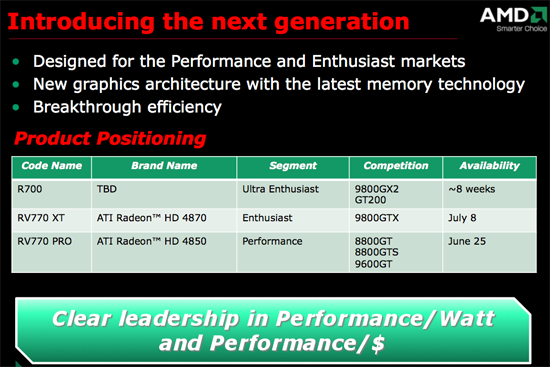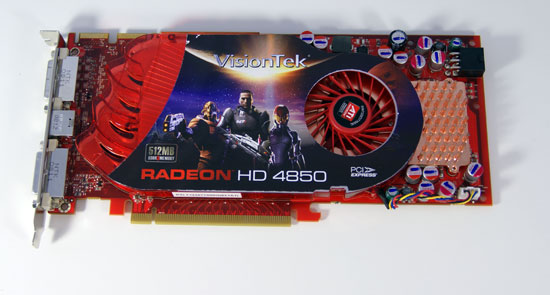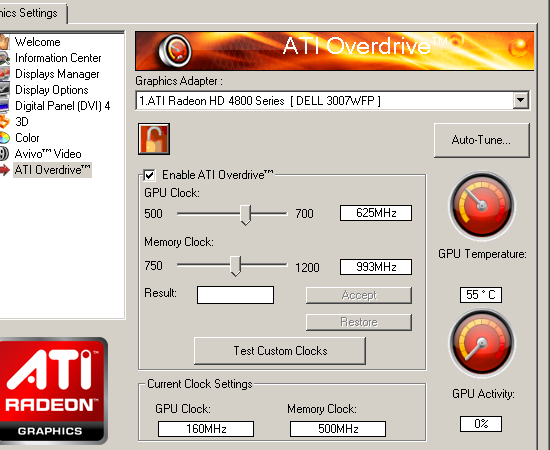ATI Radeon HD 4850 Preview: AMD Delivers Performance for the Masses
by Anand Lal Shimpi & Derek Wilson on June 19, 2008 5:00 PM EST- Posted in
- GPUs
It's been one of those long nights, the type where you don't really sleep but rather nap here and there. Normally such nights are brought on by things like Nehalem, or NVIDIA's GT200 launch, but last night was its own unique flavor of all-nighter.
On Monday, AMD had a big press event to talk about its next-generation graphics architecture. We knew that a launch was impending but we had no hardware nor did we have an embargo date when reviews would lift, we were at AMD's mercy.
You may already know about one of AMD's new cards: the Radeon HD 4850. It briefly appeared for sale on Amazon, complete with specs, before eventually getting pulled off the site. It turns out that other retailers in Europe not only listed the card early but started selling them early. In an effort to make its performance embargoes meaningful, AMD moved some dates around.
Here's the deal: AMD is launching its new RV770 GPU next week, and just as the RV670 that came before it, it will be available in two versions. The first version we can talk about today: that's the Radeon HD 4850. The second version, well, just forget that I even mentioned that - you'll have to wait until the embargo lifts for more information there.

But we can't really talk about the Radeon HD 4850, we can only tell you how it performs and we can only tell you things you would know from actually having the card. The RV770 architectural details remain under NDA until next week as well. What we can tell you is how fast AMD's new $199 part is, but we can't tell you why it performs the way it does.
We've got no complaints as we'd much rather stay up all night benchmarking then try to put together another GT200 piece in a handful of hours. It simply wouldn't be possible and we wouldn't be able to do AMD's new chips justice.
What we've got here is the polar opposite of what NVIDIA just launched on Monday. While the GT200 is a 1.4 billion transistor chip found in $400 and $650 graphics cards, AMD's Radeon HD 4850 is...oh wait, I can't tell you the transistor count quite yet. Let's just say it's high, but not as high as GT200 :)

Again, we're not allowed to go into the architectural details of the RV770, the basis for the Radeon HD 4800 series including today's 4850, but we are allowed to share whatever data one could obtain from having access to the card itself, so let's get started.
Running GPU-Z we see that the Radeon HD 4850 shows up as having 800 stream processors, up from 320 in the Radeon HD 3800 series. Remember that the Radeon HD 3800 was built on TSMC's 55nm process and there simply isn't a smaller process available for AMD to use, so the 4800 most likely uses the same manufacturing process. With 2.5x the stream processor count, the RV770 isn't going to be a small chip, while we can't reveal transistor count quite yet you can make a reasonable guess.

Clock speeds are also fair game as they are reported within GPU-Z and AMD's Catalyst control panel:

That's a 625MHz core clock and 993MHz GDDR3 memory clock (1986MHz data rate). We've got more stream processors than the Radeon HD 3870, but they are clocked a bit lower to make up for the fact that there are 2.5x as many on the same manufacturing process.
| ATI Radeon HD 4850 | ATI Radeon HD 3870 | |
| Stream Processors | 800 | 320 |
| Texture Units | I can't tell you | 16 |
| ROPs | 16 | 16 |
| Core Clock | 625MHz | 775MHz+ |
| Memory Clock | 993MHz (1986MHz data rate) | 1125MHz (2250MHz data rate) |
| Memory Bus Width | 256-bit | 256-bit |
| Frame Buffer | 512MB | 512MB |
| Transistor Count | it's a secret | 666 million |
| Manufacturing Process | TSMC 55nm | TSMC 55nm |
| Price Point | $199 | $199 |
















114 Comments
View All Comments
Sunrise089 - Friday, June 20, 2008 - link
Derrick should really clarify the source of the problem then Jarred. We all know on forums everyone says you need a 600 watt PS to even run integrated graphics, but one reason I love AT's real power draw numbers is that they show how little power most sane systems really need. But casually mentioning a 1KW unit isn't enough for even 4850 CF and not explaining further is about as close to pure FUD as I've seen here.DerekWilson - Friday, June 20, 2008 - link
all these tests have been done at Anand's place and at-the-wall power should not be a problem for any of these recent articles.we did have problems with our 1kW thermaltake and our 1kW ocz PSUs with the GTX 280 in SLI. we couldn't get through a crysis run.
in testing 4850 crossfire, the 1kW ocz power supply (elite xtreme) failed during call of duty.
we had no problems with the 1200 W pcp&c turbo cool PSU we now have installed.
our peak power numbers were shown using one of 3dmarks GPU only feature tests. this is in order to isolate GPU power as much as possible for comparison purposes between different graphics cards.
power draw at the wall will be MUCH larger when playing an actual game. this is because the CPU will be under load and system memory will likely be hit harder as well. we will also see the hard disk active as well.
i do apologize for not explaining it further. knowing what app we used to test power would probably have done enought to explain why the PSU crashed under game tests but not under our power test with a 1kW PSU ...
4850 crossfire and up and gt200 sli and up will absolutlely massive ammounts of power to run. we would be the first to say that a 1kW PSU was enough if it were -- but it is not.
semo - Saturday, June 21, 2008 - link
so how much are you drawing at the wall. just saying "MUCH larger" doesn't mean anything.this also doesn't make much difference as power ratings refer to how much can be delivered to the system - not how much can be pulled from the socket.
in other words, there seems to be some confusion. could we get some clarification the next time you do a review for GPUs (e.g. at 4870's launch)
flagpole - Saturday, June 21, 2008 - link
I have a 650w Silverstone Zeus ST650ZF powering my system right now, and it's handling a pair of 4850's Crossfire'd fine.Not to mention the 4 harddrives, 5x 120mm fans, Swiftech water pump, an AMD 64X2 4400+ @ 2.7 Ghz, plus various other things like LED's and Cathode tubes sucking back power as well.
HOOfan 1 - Friday, June 20, 2008 - link
How about the fact that nvidia has 2 CWT built 1000W systems certified on SLIzone for dual GTX 280.It really perplexes me that you guys think a 1Kw PSU wouldn't be enough for GTX 280 SLi or for 4850 Crossfire. an 800+ Watt PSU should be enough for either. Nvidia even certified the Zalman 850 Watt for dual 9800GX2. Jonnyguru stated that there was a problem specific to the GTX 280 that was not the fault of the PSUs.
I think you guys really ought to have a talk with nVidia and ATI about this before you just claim that a 1Kw PSU isn't enough for dual GPU for these two cards...because quite honestly that claim sounds rather preposterous to me.
strikeback03 - Friday, June 20, 2008 - link
I was wondering the same - the review says they had power supply problems with 2 4850s in CF, even though the table directly above says that configuration drew 335.7W total system power.Sunrise089 - Thursday, June 19, 2008 - link
Why the heck are you guys have power supply failures with this card? I know it draws a decent amount of power, but when you're load numbers are less than HALF the rating of the power supply something seems fishy.BPB - Thursday, June 19, 2008 - link
I thought these cards are to be better than current ATI cards for HD movies. Did you get a chance to play any movies? And if so, ho was the audio?jay401 - Thursday, June 19, 2008 - link
75C idle, 90C load is insane, i don't care how well the components can tolerate it. It's like an oven inside your case, and -something- will give eventually on it because those temps are nuts. Why does AMD/ATI have such trouble putting out reasonably-temped cards even after yet another die shrink? :(Clauzii - Saturday, June 21, 2008 - link
They used the die-shrink to ramp up performance, which they needed AND achieved :)I hope some Arctic cooling solution will show up even though two slots might be used.